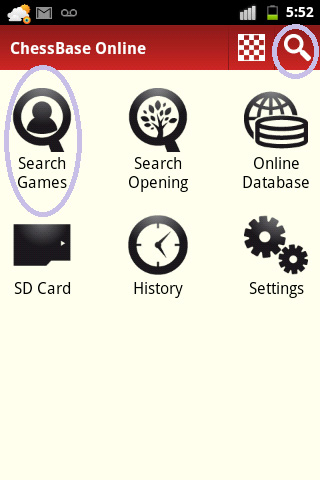


In many, if not most, of today’s tournaments, demanding faster and fewer rounds, the chances are you will play more than one round a day and professional quality opponent preparation may seem an impossible task. Of course, you could lug around a laptop, but for most players this is impractical and onerous.
That said, with an Android smartphone, any kind of internet access (it can be slow as snails and still get the job done) and the new Chessbase Online for Android app, you really have all you need. The following article will show you how you can use it to quickly prepare against opponents, and enter the game feeling ready to face their prized opening weapons.
The screenshots are all taken from my 3-inch, low-resolution (320 x 480) mobile phone, to show you don’t need a large screen or fancy hardware.
If you need to manually connect to the internet, be sure to do so first. Upon loading the program, you are presented with the home screen. Since the subject is opponent preparation, let’s click on the Search Games icon, though the Search function will do the job just as well.

All roads lead to Rome, or in this case to search
options
In this case, I’ll take GM Simon Williams and simulate discovering I am to play him as White. I'll also simulate (fantasize) that this will somehow protect me from his grandmasterfulness.

Although this is a screenshot, it is worth mentioning that
this is originally a three-inch image.
After searching his name and the year, I am shown a list of his games, but unfiltered. Since I play 1.e4, and have no idea what he replies with, let’s filter by color to only see his games as Black. To do this, just press on any of the games in the list, and keep it pressed for a couple of seconds before letting go. A small menu will appear. For our purposes, let’s click on Filter Black.

Choose any game and press on it for at least two to three seconds before letting go
to see the extra filter.
The list now shows only games with Black played in 2011. Atfer playing through several of his games, at least the openings, it is clear he plays the French Defense quite a bit, and the occasional 1…c5. In at least one of them, after 1.e4 c5 2.c3, he replied 2…e6 against IM Sam Collins and after 3.d4 transposed into a French with 3...d5.
Ok, let’s keep it simple, and get ready to face the French. Since Collins won his game, let’s see how the opening went. The opening is a bit of an unknown after his choice of 4.exd5, so a bit of help from the database statistics would be welcome.

The move played is not the overwhelming favorite
It is no surprise that 4.e5, transposing to the French Advance is the most popular reply, but it may also be what my opponent will be best prepared for, so let’s stick with Collins’s choice. We play through their choices, watching the statistics, until 11.Bg5. Stats may not be perfect, but its record is only 46%, compared to the more popular 11.Re1 with 59%.

11.Re1 seems like a better choice
Ok, we may have something now. After, the line goes either 11…Bg4, so we check it and the top choices. We can go back using the arrow buttons, and check the other options such as 11…Nf5 by clicking on them in the menu. If you get lost in the lines, you can click on the notation icon (see diagram above), and see the notation, including all the variations that have been looked at. One can continue to use the arrow buttons or one can just click on the moves directly in the notation. To see the stats of a move, click on the stats button again.

In landscape mode (screen is sidewards) the board may be smaller, but the notation
pane is larger. One can jump to a position just by clicking on the move, and then press
the stats button at the top...

...to instantly see the statistics of the position.
By now, we have managed to see what our opponent has been playing this year, and prepare something specifically against him. Granted, statistics are far from perfect, and won’t tell you the secrets behind the openings as an instructional work would, but ultimately it is far better than entering a game blind and praying your opponent plays one of your pet lines.
One final tip: do not check up on this in the bathroom, especially if you are in the last round and have already secured your IM norm.